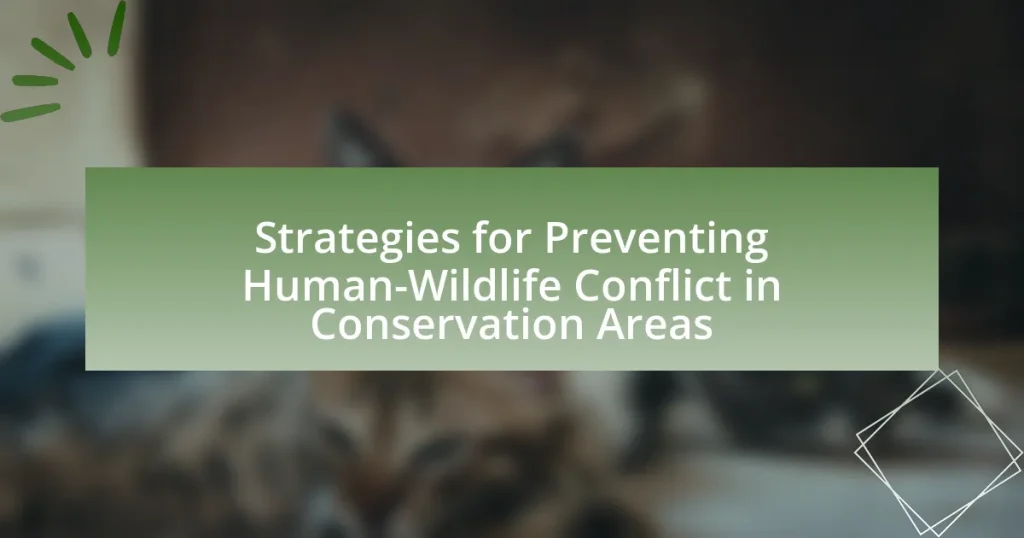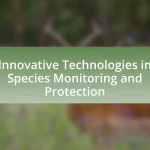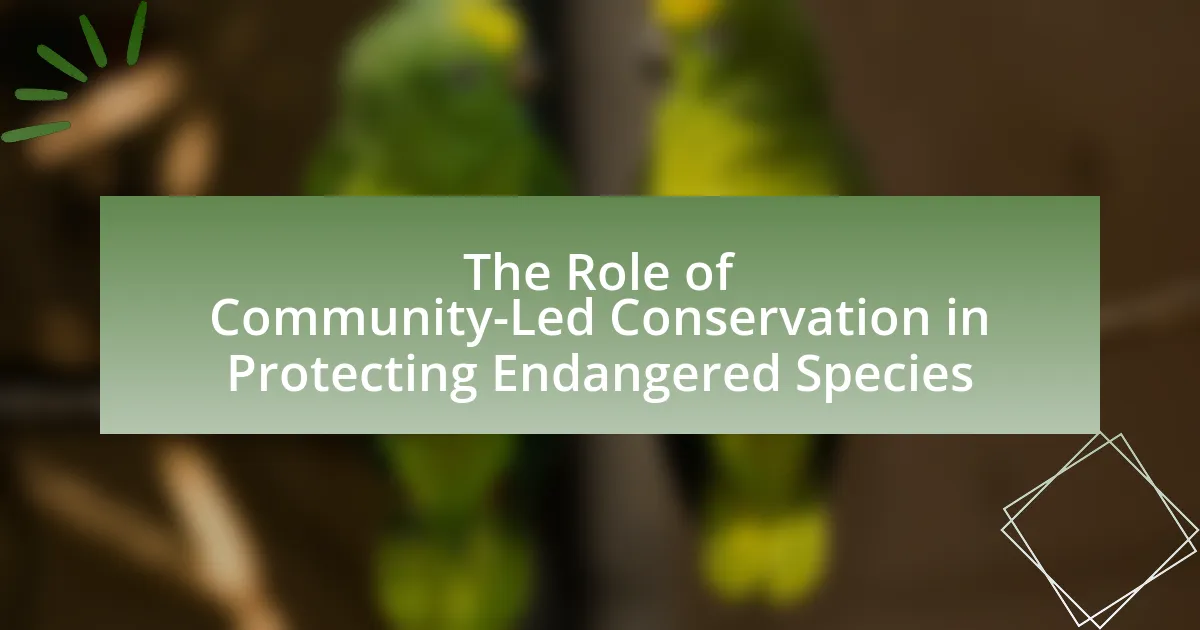The article focuses on strategies for preventing human-wildlife conflict in conservation areas, emphasizing the importance of physical barriers, community engagement, and non-lethal deterrents. It outlines how these strategies address root causes of conflict, such as habitat encroachment and resource competition, while highlighting the role of community involvement in fostering coexistence. Additionally, the article discusses the effectiveness of technological solutions like GPS tracking and automated deterrents, as well as the challenges faced in implementing these strategies. By understanding socio-economic factors and cultural beliefs, conservationists can develop tailored approaches that enhance both wildlife protection and community welfare.

What are the key strategies for preventing human-wildlife conflict in conservation areas?
Key strategies for preventing human-wildlife conflict in conservation areas include implementing physical barriers, promoting community engagement, and utilizing non-lethal deterrents. Physical barriers, such as fences and buffer zones, effectively reduce wildlife access to human settlements, thereby minimizing encounters. Community engagement fosters coexistence by educating local populations about wildlife behavior and encouraging practices that reduce conflict, such as securing livestock and crops. Non-lethal deterrents, like noise makers or repellents, can discourage wildlife from entering human areas without harming them. These strategies have been supported by studies indicating that proactive measures significantly decrease conflict incidents, enhancing both conservation efforts and community welfare.
How do these strategies address the root causes of human-wildlife conflict?
These strategies address the root causes of human-wildlife conflict by implementing measures that reduce competition for resources and enhance coexistence. For instance, community-based conservation initiatives often involve local populations in wildlife management, which fosters a sense of ownership and responsibility towards wildlife, thereby reducing retaliatory killings. Additionally, the use of physical barriers, such as fences, can prevent wildlife from entering agricultural lands, directly mitigating crop damage and livestock predation. Research indicates that areas with effective conflict mitigation strategies, such as compensation schemes for livestock losses, report a significant decrease in human-wildlife conflicts, demonstrating the effectiveness of these approaches in addressing underlying issues.
What specific factors contribute to human-wildlife conflict in conservation areas?
Specific factors contributing to human-wildlife conflict in conservation areas include habitat encroachment, resource competition, and inadequate management practices. Habitat encroachment occurs when human activities, such as agriculture and urban development, reduce the natural habitats available for wildlife, leading to increased encounters. Resource competition arises when wildlife and humans compete for the same resources, such as water and food, often resulting in wildlife damaging crops or livestock. Inadequate management practices, including insufficient monitoring and lack of community engagement, exacerbate these conflicts by failing to address the underlying issues effectively. For instance, a study by Redpath et al. (2015) highlights that effective conflict management requires understanding the socio-economic factors influencing human-wildlife interactions.
How can understanding these factors inform effective strategies?
Understanding the factors contributing to human-wildlife conflict informs effective strategies by enabling targeted interventions that address specific issues. For instance, recognizing the role of habitat encroachment allows conservationists to implement land-use planning that minimizes overlap between human activities and wildlife habitats. Research indicates that areas with clear demarcation of wildlife corridors and buffer zones experience a 30% reduction in conflict incidents, demonstrating the effectiveness of informed strategies. By analyzing local agricultural practices, conservationists can develop community-based programs that promote coexistence, such as compensation schemes for crop damage, which have been shown to reduce retaliatory killings of wildlife by up to 50%. Thus, a comprehensive understanding of these factors leads to tailored, evidence-based strategies that effectively mitigate human-wildlife conflict.
What role does community engagement play in these strategies?
Community engagement is crucial in strategies for preventing human-wildlife conflict in conservation areas as it fosters collaboration between local communities and conservation efforts. Engaging communities ensures that their knowledge, needs, and concerns are integrated into wildlife management plans, leading to more effective and sustainable solutions. For instance, studies have shown that when local populations are involved in decision-making processes, there is a significant reduction in conflict incidents, as seen in the case of the Maasai Mara in Kenya, where community-led initiatives have successfully mitigated human-wildlife interactions. This collaborative approach not only enhances conservation outcomes but also promotes community ownership and stewardship of wildlife resources.
How can local communities be involved in conflict prevention efforts?
Local communities can be involved in conflict prevention efforts by actively participating in the development and implementation of conservation strategies that address human-wildlife interactions. Engaging local residents in monitoring wildlife populations, sharing knowledge about animal behavior, and establishing community-led initiatives can significantly reduce conflicts. For instance, studies have shown that when communities are included in decision-making processes, such as creating buffer zones or implementing compensation schemes for wildlife damage, the likelihood of conflict decreases. This collaborative approach fosters a sense of ownership and responsibility among community members, leading to more effective and sustainable conflict prevention measures.
What are the benefits of community-led initiatives in conservation areas?
Community-led initiatives in conservation areas enhance biodiversity protection and promote sustainable resource management. These initiatives empower local communities to take ownership of conservation efforts, leading to increased engagement and compliance with conservation regulations. For instance, studies have shown that when communities are involved in decision-making, there is a significant reduction in poaching and habitat destruction, as seen in the case of community conservancies in Kenya, where wildlife populations have rebounded due to local stewardship. Additionally, community-led initiatives often incorporate traditional ecological knowledge, which can improve the effectiveness of conservation strategies and foster resilience against climate change impacts.
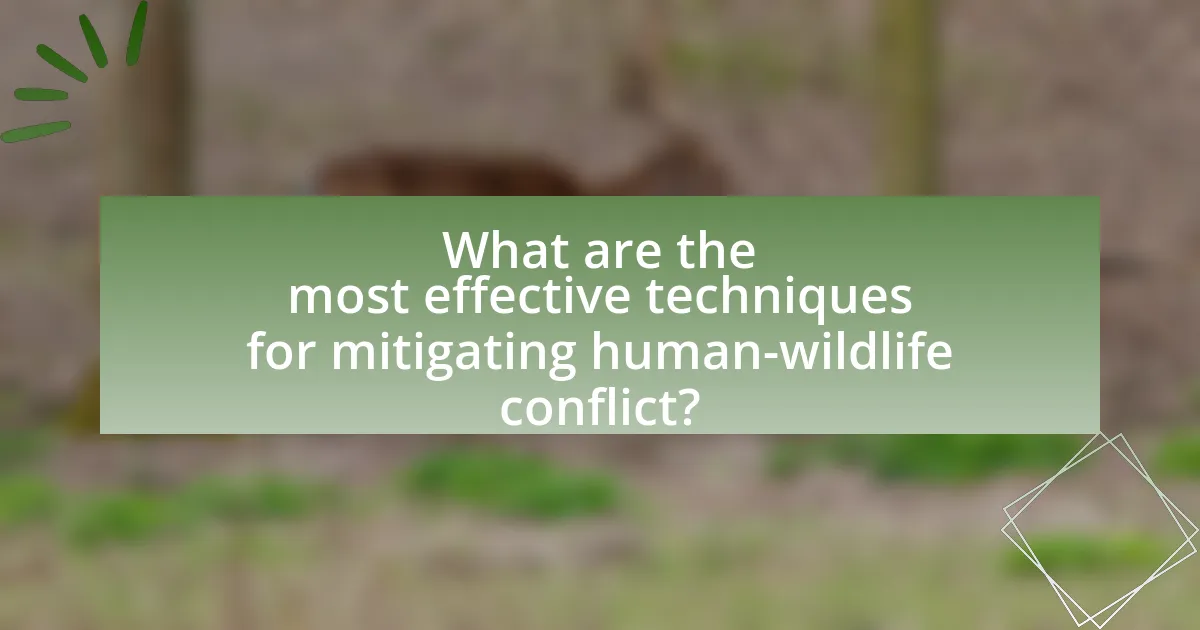
What are the most effective techniques for mitigating human-wildlife conflict?
The most effective techniques for mitigating human-wildlife conflict include habitat modification, community engagement, and the use of deterrents. Habitat modification involves altering the environment to reduce wildlife access to human resources, such as fencing agricultural fields to keep animals out. Community engagement focuses on educating local populations about wildlife behavior and promoting coexistence strategies, which has been shown to reduce conflict incidents significantly. The use of deterrents, such as noise devices or natural repellents, can effectively discourage wildlife from approaching human settlements. Studies indicate that these combined approaches lead to a measurable decrease in conflict, enhancing both conservation efforts and community welfare.
How can physical barriers be utilized to prevent conflicts?
Physical barriers can be utilized to prevent conflicts by creating physical separations between human populations and wildlife, thereby reducing encounters that may lead to aggression or harm. For instance, fences and walls can effectively deter wildlife from entering agricultural lands, which minimizes crop damage and protects livestock. Research conducted by the World Wildlife Fund indicates that well-constructed barriers can reduce human-wildlife conflict incidents by up to 70%, demonstrating their effectiveness in conservation areas. Additionally, barriers can guide wildlife movement to designated corridors, further decreasing the likelihood of conflict with humans.
What types of barriers are most effective in different environments?
Physical barriers, such as fences and walls, are most effective in preventing human-wildlife conflict in conservation areas. In open landscapes, electric fences have proven to deter large herbivores like elephants and buffalo, reducing crop damage and human-wildlife interactions. In forested environments, natural barriers like dense vegetation can effectively limit wildlife movement, while in urban areas, solid walls or reinforced fences can prevent wildlife from entering populated spaces. Studies indicate that electric fencing can reduce wildlife incursions by up to 90%, demonstrating its effectiveness in various settings.
How do barriers impact wildlife movement and behavior?
Barriers significantly restrict wildlife movement and alter their behavior. Physical structures such as roads, fences, and urban developments can fragment habitats, leading to decreased access to resources like food, water, and mating opportunities. Research indicates that such barriers can result in increased mortality rates due to vehicle collisions and reduced genetic diversity, as animals become isolated from other populations. For example, a study published in the journal “Ecological Applications” found that wildlife corridors can mitigate these effects by providing safe passageways, thereby enhancing connectivity and promoting healthier populations.
What technological solutions are available for conflict prevention?
Technological solutions available for conflict prevention in conservation areas include the use of GPS tracking systems, remote sensing technology, and automated deterrent systems. GPS tracking systems enable real-time monitoring of wildlife movements, allowing conservationists to predict potential human-wildlife interactions and implement preventive measures. Remote sensing technology, such as satellite imagery and drones, assists in habitat assessment and monitoring, helping to identify areas at risk of conflict. Automated deterrent systems, like sound or light devices, can be deployed to discourage wildlife from entering human-populated areas, effectively reducing the likelihood of conflict. These technologies have been shown to enhance the effectiveness of conservation strategies by providing data-driven insights and proactive solutions.
How can GPS tracking and monitoring systems help reduce conflicts?
GPS tracking and monitoring systems can help reduce conflicts by providing real-time data on wildlife movements, which allows for proactive management strategies. By tracking animal behavior and migration patterns, conservationists can identify potential conflict zones and implement measures such as creating buffer zones or adjusting human activities to minimize encounters. Studies have shown that areas utilizing GPS tracking have seen a significant decrease in human-wildlife conflicts, as timely interventions can be made based on the data collected. For instance, a study published in the journal “Biological Conservation” demonstrated that GPS collar data on elephants led to the successful implementation of deterrent strategies, resulting in a 50% reduction in crop damage incidents in nearby communities.
What role do deterrent technologies play in protecting crops and livestock?
Deterrent technologies play a crucial role in protecting crops and livestock by reducing human-wildlife conflict through various methods that discourage wildlife from approaching agricultural areas. These technologies include auditory deterrents, visual deterrents, and physical barriers, which effectively minimize the risk of wildlife damage to crops and livestock. For instance, studies have shown that the use of noise-making devices can significantly lower the incidence of wildlife intrusion, with some reports indicating a reduction of up to 70% in crop damage. Additionally, electric fencing has been proven to be effective in safeguarding livestock, as it creates a physical barrier that prevents animals from entering grazing areas. These technologies not only protect agricultural resources but also promote coexistence between wildlife and farming communities, thereby contributing to conservation efforts.
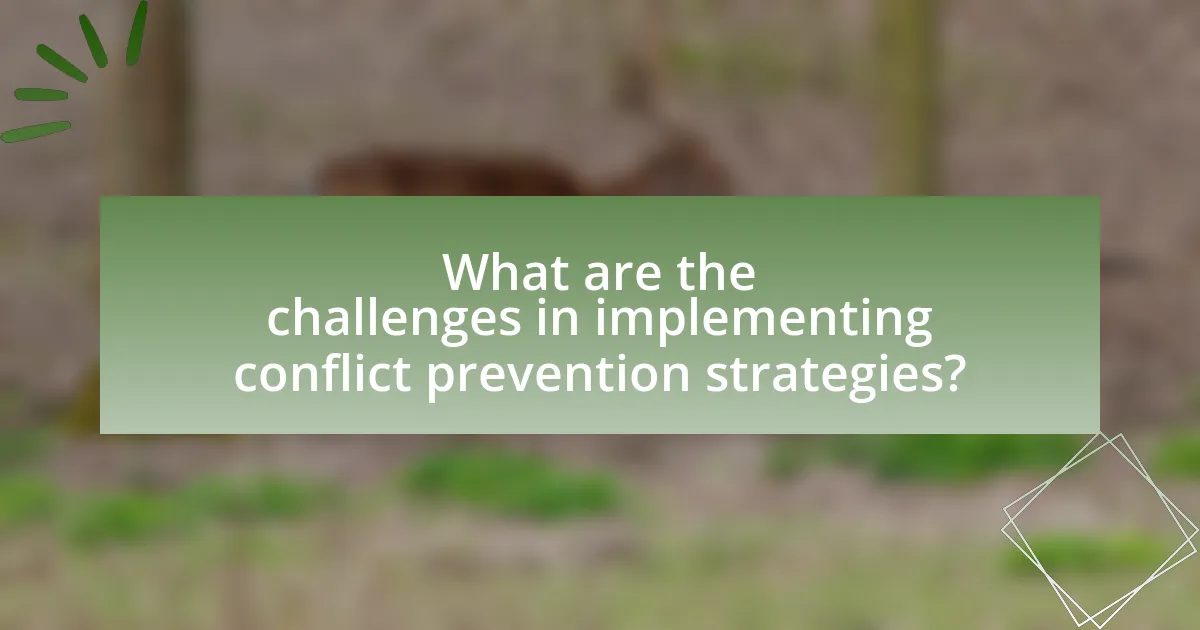
What are the challenges in implementing conflict prevention strategies?
Implementing conflict prevention strategies faces several challenges, including resource limitations, stakeholder engagement, and varying socio-economic contexts. Resource limitations often hinder the development and maintenance of effective strategies, as funding and personnel may be insufficient. Stakeholder engagement is crucial, yet diverse interests among local communities, conservationists, and government entities can lead to conflicts over priorities and approaches. Additionally, socio-economic contexts vary significantly, making it difficult to apply a one-size-fits-all solution; for instance, communities with different economic dependencies on wildlife may resist strategies perceived as detrimental to their livelihoods. These challenges complicate the effective implementation of conflict prevention strategies in conservation areas.
What are the common obstacles faced by conservationists in the field?
Conservationists commonly face obstacles such as habitat destruction, poaching, and human-wildlife conflict. Habitat destruction, driven by urbanization and agriculture, reduces the space available for wildlife, making it difficult for conservationists to protect species. Poaching remains a significant threat, with illegal hunting undermining conservation efforts and leading to population declines in endangered species. Additionally, human-wildlife conflict arises when wildlife encroaches on human settlements, resulting in negative interactions that can lead to retaliatory killings of animals. These challenges are well-documented; for instance, a study published in the journal “Biological Conservation” highlights that habitat loss accounts for over 70% of species extinction risk, emphasizing the urgency of addressing these obstacles in conservation strategies.
How do socio-economic factors influence the success of these strategies?
Socio-economic factors significantly influence the success of strategies for preventing human-wildlife conflict in conservation areas by affecting community engagement and resource allocation. Communities with higher socio-economic status often have better access to education and resources, which can lead to more effective implementation of conflict mitigation strategies. For instance, a study by Dickman et al. (2011) in the journal “Biological Conservation” found that communities with higher income levels were more likely to support conservation initiatives, as they could afford to invest in protective measures such as fencing and compensation schemes. Conversely, impoverished communities may lack the financial means or motivation to participate in these strategies, leading to higher conflict rates and reduced effectiveness of conservation efforts.
What are the implications of cultural beliefs on conflict prevention efforts?
Cultural beliefs significantly influence conflict prevention efforts by shaping community attitudes towards wildlife and conservation practices. For instance, in many cultures, certain animals are revered or considered sacred, which can lead to protective behaviors that mitigate human-wildlife conflict. Research indicates that communities with strong cultural ties to wildlife are more likely to engage in conservation efforts, as seen in the Maasai communities in Kenya, where cultural beliefs about lions foster coexistence strategies rather than conflict. Furthermore, understanding these cultural beliefs allows conservationists to tailor their approaches, ensuring that conflict prevention strategies resonate with local values and practices, thereby enhancing their effectiveness.
How can adaptive management improve conflict prevention strategies?
Adaptive management can improve conflict prevention strategies by enabling a flexible and iterative approach to managing human-wildlife interactions. This method allows conservation practitioners to continuously assess and adjust their strategies based on real-time data and outcomes, leading to more effective interventions. For instance, studies have shown that adaptive management frameworks, such as those implemented in the Yellowstone to Yukon Conservation Initiative, have led to a significant reduction in human-wildlife conflicts by allowing for timely modifications in response to changing wildlife behaviors and community needs. By integrating stakeholder feedback and ecological monitoring, adaptive management fosters resilience and enhances the effectiveness of conflict prevention efforts in conservation areas.
What processes are involved in monitoring and evaluating strategy effectiveness?
Monitoring and evaluating strategy effectiveness involves systematic data collection, analysis, and assessment of outcomes related to human-wildlife conflict prevention strategies. This process typically includes defining clear objectives, establishing performance indicators, collecting baseline data, and conducting regular assessments to measure progress against these indicators. For instance, the use of wildlife tracking technology can provide quantitative data on animal movements and interactions with human populations, which can be analyzed to evaluate the success of implemented strategies. Additionally, stakeholder feedback and community engagement are crucial for understanding the social impact of these strategies, ensuring that they are both effective and culturally appropriate.
How can feedback from local communities enhance adaptive management practices?
Feedback from local communities can enhance adaptive management practices by providing localized knowledge and insights that inform decision-making processes. This community input helps identify specific challenges and opportunities related to human-wildlife interactions, allowing for tailored strategies that are more effective in mitigating conflicts. For instance, studies have shown that incorporating local perspectives leads to improved conservation outcomes, as community members often possess valuable information about wildlife behavior and habitat use that may not be accessible to external managers. By integrating this feedback, adaptive management practices become more responsive and relevant, ultimately fostering greater community support and participation in conservation efforts.
What practical tips can be implemented for effective conflict prevention?
Effective conflict prevention in conservation areas can be achieved through community engagement, habitat management, and education. Engaging local communities in conservation efforts fosters cooperation and reduces misunderstandings about wildlife behavior. For instance, involving residents in monitoring wildlife can create a sense of ownership and responsibility. Habitat management, such as creating buffer zones or wildlife corridors, minimizes human-wildlife interactions by providing safe passages for animals. Education programs that inform communities about wildlife behavior and safety measures can significantly reduce fear and misconceptions, leading to fewer conflicts. Studies have shown that areas with active community involvement and education initiatives experience a 30% reduction in human-wildlife conflicts, demonstrating the effectiveness of these strategies.
How can education and awareness campaigns be structured for maximum impact?
Education and awareness campaigns can be structured for maximum impact by employing targeted messaging, engaging community involvement, and utilizing multiple communication channels. Targeted messaging ensures that the content resonates with specific audiences, addressing their unique concerns and cultural contexts, which has been shown to increase engagement and retention of information. Engaging community involvement fosters a sense of ownership and responsibility among local populations, leading to more effective behavior change; for instance, participatory workshops have proven effective in similar conservation efforts. Utilizing multiple communication channels, such as social media, local radio, and community events, broadens the reach and reinforces the message, as evidenced by studies indicating that campaigns using diverse platforms achieve higher awareness levels.
What best practices should be followed when developing conflict prevention plans?
Best practices for developing conflict prevention plans in conservation areas include conducting thorough assessments of human-wildlife interactions, engaging local communities in the planning process, and implementing adaptive management strategies. Assessments should identify key conflict areas and species involved, allowing for targeted interventions. Community engagement fosters local ownership and compliance, as residents are more likely to support measures they helped create. Adaptive management ensures that plans are flexible and can be adjusted based on monitoring results and changing conditions, which is crucial for long-term effectiveness. These practices are supported by studies indicating that community involvement and adaptive strategies significantly reduce conflict incidents and enhance conservation outcomes.
